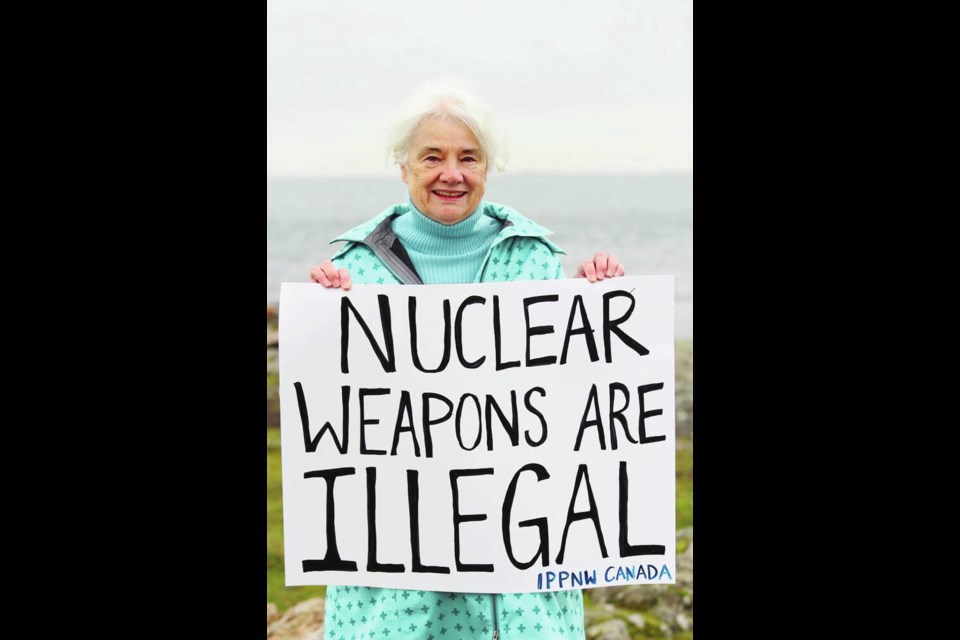For many people, the concept of world peace may seem like a distant dream. For nearly 40 years, Dr. Mary-Wynne Ashford made it her mission, becoming active in the nuclear disarmament movement after hearing Dr. Helen Caldicott speak at the University of Victoria in 1984.
She was still teaching an online course on the subject when she passed away on Nov. 19 from complications after falling and hitting her head in Victoria. She was 83.
“Mary-Wynne was someone who always looked for solutions to problems,” said Sheila Flood, executive director of the Victoria Multifaith Society. “It was an endearing characteristic, her optimism that humanity could and would find its way out of the mess it’s in, no matter what the crisis.”
Flood said part of that was Ashford’s grounding in Baha’i philosophy “that teaches that oneness requires work — it’s something that has to be brought down to earth and made concrete.”
Born the third of four children to Jack and Kitty Moar on March 17, 1939, in Indian Head, Saskatchewan, Ashford graduated with a bachelor of education and bachelor of science in home economics from the University of Alberta. She went on to earn a medical degree in 1991 and practiced as a family and palliative-care physician.
She was co-president from 1998-2002 of International Physicians for the Prevention of Nuclear War, which won the Nobel Peace Prize in 1985, and led two delegations of the group to North Korea, in 1999 and 2000.
“She was as sharp as a tack and cared — not just for her patients but for the entire world,” said Dr. Jonathan Down, a Victoria pediatrician and president of International Physicians for the Prevention of Nuclear War Canada. “She felt that she had a duty of care to prevent a nuclear incident — the ultimate public threat.”
Ashford wrote a book called Enough Blood Shed: 101 Solutions to Violence, Terror and War that was published in 2006, and gave talks locally and internationally.
“She always said that the way forward was to speak from the heart — and to speak often,” said Down. “Mary-Wynne never gave up hope that change was possible. She always said ‘yes’ to any invitation to speak. She would talk about how everybody had a part to play in the end goal of the abolition of nuclear weapons.”
Down said that in the last three decades, the stockpile of nuclear weapons has decreased from a high of 70,000 warheads to about 14,000 today.
While few in the wider community might have known about her work, Ashford was known and loved within the peace community.
Bill Geimer, director of Greater Victoria Peace School, calls her a “hero for peace.” “She was our quietly effective peacemaker, and we may not see her like again.”
Awards she received over the years include the Queen Elizabeth II Golden Jubilee Medal from the Governor General, the Gandhi Prize, the Award of Excellence from Doctors of B.C. and, with Down, the 2019 Distinguished Achievement Award from the Canadians for a Nuclear Weapons Convention.
In 2018, she joined 1,200 women from around the world to walk across the Reunification Bridge, which separates North and South Korea, as part of a women’s peace march.
“Women have played a significant role in the movement toward peace,” Ashford said in a Times Colonist piece in June 2018. “As peace negotiations progress, it is now essential that women be fully engaged in the talks.”
Son Graham Ashford, 56, who lives in Australia, said his mother encouraged experimental learning. “She always had time for crafts, games and magic shows.”
Ashford, one of her three children and four stepchildren, said his father worked in the medical lab at the Calgary Zoo, and at one point the family became foster parents to two orangutans, Buffy and Kalimantan, who had been rejected by their mother. They later hosted a polar bear at their home for four months.
“She was polite but firm,” he said. “At a younger age she had taken drama at school. So when she put on a ‘voice,’ she always managed to get people’s attention.”
Down said Mary-Wynne had charisma. “You could hear a pin drop in an auditorium when she spoke.”
She loved to sing and performed with the Gettin’ Higher Choir and the Community Choir Leadership Training.
Her sewing skills were renowned. She created special “therapy puppets” that were used to encourage Syrian refugee children recount stories of their trauma and journeys to Canada.
She joined the Baháʼí faith in 2008 and was an active member of the community, promoting the teachings, particularly those that elaborated on aspects of world peace and global governance.
Ashford never lost hope that the world would one day be nuclear-weapons-free. For a number of years, she and Down would go to high schools to teach about the atomic bomb, the Cold War and the Treaty to Ban Nuclear Weapons.
When the pandemic put the program in hiatus, Ashford developed an online course called Global Solutions for Peace, Equality and Sustainability, through NextGenU.
She was teaching the course until her death.
“She had plans for the future and the energy required for the long haul. She was taken too soon,” said Down.
Condolences can be left at marywynneashford.ca. In lieu of flowers, the family asks that people contribute to a cause in her honour.



